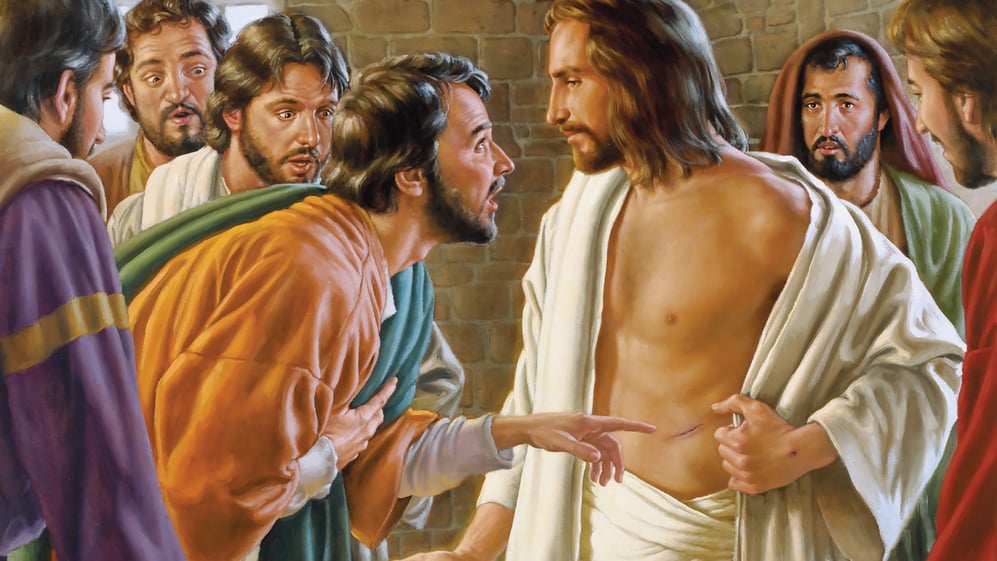This month, we turn our attention to teaching about the apostle Thomas. We’ll begin with a few introductory verses followed by information from the Bible regarding this apostle, and finally, suggestions on how to present Thomas in the Sunday School setting.
Key Verses
John 14:5
Thomas said to Him, “Lord, we do not know where You are going. How can we know the way?”
John 20:19–20
On the evening of that day, the first day of the week, the doors being locked where the disciples were for fear of the Jews, Jesus came and stood among them and said to them, “Peace be with you.” When He had said this, He showed them His hands and His side. Then the disciples were glad when they saw the Lord.
John 20:24–28
Now Thomas, one of the twelve, called the Twin, was not with them when Jesus came. So the other disciples told him, “We have seen the Lord.” But he said to them, “Unless I see in His hands the mark of the nails, and place my finger into the mark of the nails, and place my hand into His side, I will never believe.”
Eight days later, His disciples were inside again, and Thomas was with them. Although the doors were locked, Jesus came and stood among them and said, “Peace be with you.” Then He said to Thomas, “Put your finger here, and see My hands; and put out your hand, and place it in My side. Do not disbelieve, but believe.” Thomas answered Him, “My Lord and my God!”
What We Know about Thomas
- He was also called “Twin,” or Didymus (John 11:16).
- He expressed skepticism when Jesus returned to Bethany to raise Lazarus from the dead (John 11:16).
- He struggled to truly understand Jesus’ work as our Savior (John 14:5–6).
- He was not present with the other apostles at Jesus’ first appearance following His resurrection (John 20:24).
- He doubted that Christ had truly risen from the dead (John 20:25).
- He placed his hand in the Lord’s side following His resurrection (John 20:27).
- Thomas was the first disciple on record to claim that the risen Jesus is God (John 20:28).
Doubting Thomas
Christians use the expression “doubting Thomas” in reference to the apostle’s skepticism of the Lord’s resurrection. However, many unbelieving people use this phrase too. Many apply this title to those who doubt without even realizing the phrase’s connection to the Bible. Another example of unbelievers referencing the Bible without knowing it is by using the phrase “the writing is on the wall,” which is a reference to Daniel chapter five when a hand appeared and wrote on the wall in the presence of King Nebuchadnezzar. Like that reference, “doubting Thomas” has become a part of everyday speech.
Thomas wouldn’t believe that Christ has risen from the dead since he was not among those present at the tomb of the Lord’s resurrection, nor Jesus’ first appearance to the apostles. Although unbelief in Jesus and His words are sinful for both Christians and unbelievers, we should take care of condemning Thomas’s reaction. There is no reason to assume that the other disciples present at the tomb or the first appearance expected Jesus to rise from the dead any more than Thomas did.
Ultimately, Thomas’s doubt has its roots in sinfulness. By nature, we are God’s enemies and are incapable of trusting in Jesus until the Holy Spirit enables us through the Gospel. It’s important to convey this to Sunday School students. What’s more, although Christians trust in Christ for salvation, we are apt to distrust God’s other promises: His unchanging love, the fullness of forgiveness in Christ, how God is three in one, how Holy Baptism saves, and how Christ is truly present in Holy Communion. Pointing this out will help students understand why Thomas was doubting and why unbelievers seem so unwilling to believe in Jesus.
Connecting Thomas to the Work of the Holy Spirit and the Means of Grace
The Bible teaches that the Lord’s Holy Spirit creates and sustains saving faith in Jesus Christ, our crucified and risen Savior. Other protestant traditions falsely teach that one can come to trust Christ and remain in faith through their own reason or effort. But this is not so. Although we are Christians, sinful nature is still present within us—and it will be until the day the Lord takes us to heaven. This wicked nature is always working to turn us from Jesus in favor of false gods, atheism, and salvation by our own goodness or efforts to please God. Thomas presents an excellent opportunity to teach on these points.
Thomas says, “Unless I see in His hands the mark of the nails, and place my finger into the mark of the nails, and place my hand into His side, I will never believe.” Like Thomas, we are quick to place our sense and reason above the Word of God. Thankfully, the Holy Spirit directs us to what is true, despite our reason and senses. Point students to their Baptism, in which the Holy Spirit enabled them to trust in Christ. Explain that in worship, Bible study, and Holy Communion, the Holy Spirit maintains and strengthens that faith. Even as the devil, the world, and our own sinful nature points us to doubt God and instead trust in anything else, the Holy Spirit works in our lives. In His love and mercy, Jesus suffered and died to save Thomas—and us. Jesus showed Thomas His crucified hands and wounded side so that the apostle would trust. The Holy Spirit shows us Christ through the Bible, Holy Baptism, and Holy Communion.
Scripture: ESV®.
Looking for more information on teaching about the twelve apostles? Browse Pastor Rigdon’s other posts by following the link below.
















